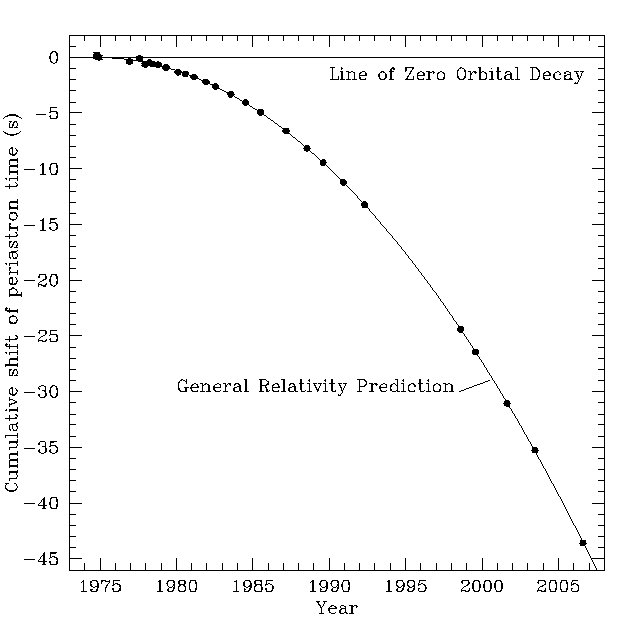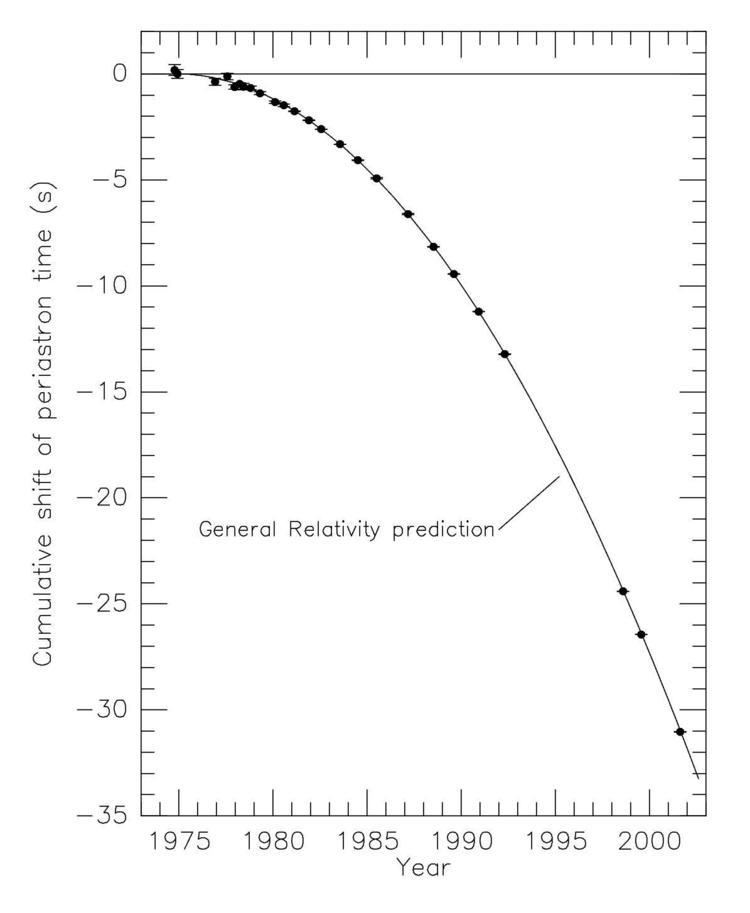Orbital period 8 hours | Magnitude 22.5 | |
 | ||
Similar PSR J0737‑3039, PSR B1257+12, SS 433, Crab Pulsar, PSR J0437‑4715 | ||
Hulse taylor binary pulsar s gravitational power emission
PSR B1913+16 (also known as PSR J1915+1606, PSR 1913+16, and the Hulse–Taylor binary after its discoverers) is a pulsar (a radiating neutron star) which together with another neutron star is in orbit around a common center of mass, thus forming a binary star system. PSR 1913+16 was the first binary pulsar to be discovered. It was discovered by Russell Alan Hulse and Joseph Hooton Taylor, Jr., of the University of Massachusetts Amherst in 1974. Their discovery of the system and analysis of it earned them the 1993 Nobel Prize in Physics "for the discovery of a new type of pulsar, a discovery that has opened up new possibilities for the study of gravitation."
Contents

Discovery

Using the Arecibo 305m antenna, Hulse and Taylor detected pulsed radio emissions and thus identified the source as a pulsar, a rapidly rotating, highly magnetized neutron star. The neutron star rotates on its axis 17 times per second; thus the pulse period is 59 milliseconds.

After timing the radio pulses for some time, Hulse and Taylor noticed that there was a systematic variation in the arrival time of the pulses. Sometimes, the pulses were received a little sooner than expected; sometimes, later than expected. These variations changed in a smooth and repetitive manner, with a period of 7.75 hours. They realized that such behavior is predicted if the pulsar were in a binary orbit with another star, later confirmed to be another neutron star. Pulses from the companion neutron star have not been detected, but this might only be the result of an unfavorable viewing angle.

The pulses from the pulsar arrive 3 seconds earlier at some times relative to others, showing that the pulsar’s orbit is 3 light-seconds across, approximately two-thirds of the diameter of the Sun. Since this is a binary system, the masses of the two neutron stars can be determined, and they are each around 1–3 times the mass of the Sun. Observations have shown that the pulsar’s orbit is gradually contracting, possibly an evidence for the emission of energy in the form of gravitational waves, as described by Einstein’s theory of general relativity, causing the pulsar to reach periastron slightly early. Also, periastron advances 4° per year in longitude due to the gravitational field (thus the pulsar’s periastron moves as far in a day as Mercury’s moves in a century).
Star system

The pulsar and its neutron star companion both follow elliptical orbits around their common center of mass. The period of the orbital motion is 7.75 hours, and the two neutron stars are believed to be nearly equal in mass, about 1.4 solar masses. Radio emissions have been detected from only one of the two neutron stars.

The minimum separation at periastron is about 1.1 solar radii; the maximum separation at apastron is 4.8 solar radii. The orbit is inclined at about 45 degrees with respect to the plane of the sky. The orientation of periastron changes by about 4.2 degrees per year in direction of the orbital motion (relativistic precession of periastron). In January 1975, it was oriented so that periastron occurred perpendicular to the line of sight from Earth.
The orbit has decayed since the binary system was initially discovered, in precise agreement with the loss of energy due to gravitational waves described by Einstein's general theory of relativity. The ratio of observed to predicted rate of orbital decay is calculated to be 0.997±0.002. The total power of the gravitational radiation (waves) emitted by this system presently, is calculated to be 7.35 × 1024 watts. For comparison, this is 1.9% of the power radiated in light by our own Sun (another comparison is that the Solar System radiates only about 5000 watts in gravitational waves, due to the much larger distances and orbit times, particularly between the Sun and Jupiter).
With this comparatively large energy loss due to gravitational radiation, the rate of decrease of orbital period is 76.5 microseconds per year, the rate of decrease of semimajor axis is 3.5 meters per year, and the calculated lifetime to final inspiral is 300 million years.
In 2004, Taylor and Joel M. Weisberg published a new analysis of the experimental data to date, concluding that the 0.2% disparity between the data and the predicted results is due to poorly known galactic constants, including the Sun's distance from the galactic center, the pulsar's proper motion and its distance from Earth. While there are efforts underway for better measurement of the first two quantities, they saw "little prospect for a significant improvement in knowledge of the pulsar distance," so tighter bounds will be difficult to attain. Taylor and Weisberg also mapped the pulsar's two-dimensional beam structure using the fact that the system's precession leads to varying pulse shapes. They found that the beam shape is latitudinally elongated, and pinched longitudinally near the centre, leading to an overall figure-of-eight shape.
